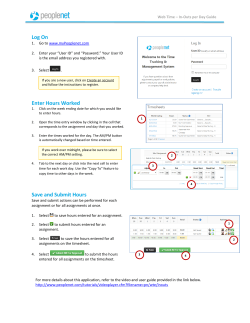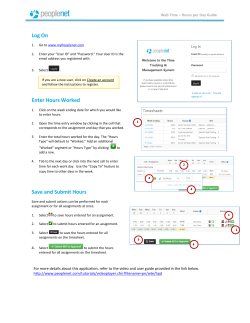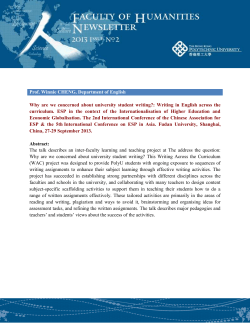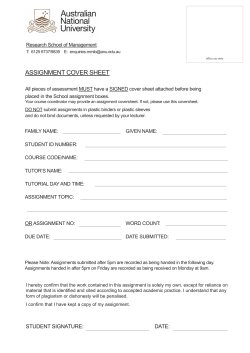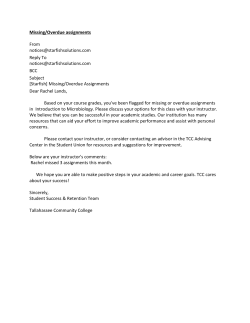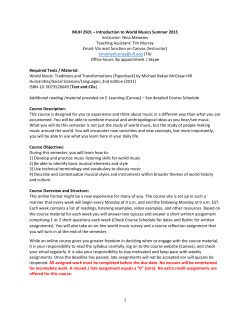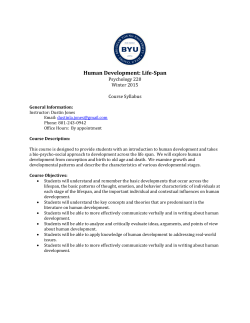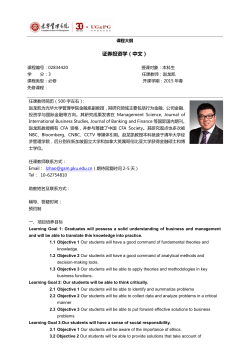
Institution: Programme : Course : Course Coordinator : Programme
Majmaah University. Institution: Academic Department : College of Science at Az Zulfi. Department of Computer Science and Information Programme : Computer Architecture (CSI 323) Course : Dr. Loai Bani Melhim Course Coordinator : Programme Coordinator : Assoc. Prof.YOSRY AZAAM 23/ 12 / 1435 H Course Specification Approved Date : A. Course Identification and General Information 1. 1 - Course title : Computer Architecture Course Code: (CSI 323) 3 credit hours (3 lecture + 1 lab) 2. Credit hours : 3 - Program(s) in which the course is offered: Computer Science and Information Program 4 – Course Language : English 2. 5 - Name of faculty member responsible for the course: th 3. 6 - Level/year at which this course is offered : 4 level 7 - Pre-requisites for this course (if any) : CSI 313 Dr.Loai Bani Melhim Computer Organization and Assembly Language 8 - Co-requisites for this course (if any) : none N/ A 9 - Location if not on main campus : )College of Science at Az Zulfi( 10 - Mode of Instruction (mark all that apply) A - Traditional classroom B - Blended (traditional and online) D - e-learning E - Correspondence F - Other √ √ √ What percentage? 80 % What percentage? 10 % What percentage? ……. % What percentage? ……. % What percentage? 10 % Comments : One-tenth of the course is presented mainly inside video lectures of other instructors worldwide. They illustrate the same topics that I introduced in my lectures with a different presentation. B Objectives What is the main purpose for this course? This course provides students with basic knowledge in: Fundamentals of computer design, Performance evaluation, Instruction set principles, Processor organization and design, Pipelining, Instruction and arithmetic pipelines, Dynamic and speculative execution, Precise exception, CISC, RISC, and VLIW processors, Memory Hierarchy, Virtual memory, Multilevel caches, Storage and I/O, Introduction to Multicore, multiprocessors, and clusters, New trends in computer architecture. Briefly describe any plans for developing and improving the course that are being implemented : 1. Increasing the ability of the students to implement the methods and practices that are Page 2 Of 8 presented in the course. 2. Formative exams during the term with a feedback to the students, so these examinations can be used as a method of learning.. 3. Using group discussion through the internet with course attending students. 4. Updating the materials of the course to cover the new topics of the field. 5. Help students to develop their knowledge about the topics that are presented in the course. C. Course Description 1. Topics to be Covered List of Topics No. of Weeks Contact Hours 1. Introduction (Computer Abstractions and Technology) 1 4 2. Instruction Set Architecture 2 8 3. Arithmetic for Computers 1 4 4. Assessing and Understanding Performance 1 4 5. Processor Design 1 4 6. Memory Hierarchy and Operation 2 8 7. Multiprocessor Systems 2 8 8. Graphics and Computing GPUs 2 8 2 8 1 4 9. Assemblers, Linkers, and the SPIM Simulator 10. A Survey of RISC Architectures for Desktop Server, and Embedded Computers 2. Course components (total contact hours and credits per semester): Lecture Tutorial Laboratory Practical Other: Total Contact Hours 30 - 30 - - 60 Credit 30 - 15 - - 45 Page 3 Of 8 3. Additional private study/learning hours expected for students per week. 5 The private self-study of my student is crucial for this course. It includes: Before the lectures start students are required to study some topics on their own. Before the lectures start students are required to study some topics on their own. The topics are straightforward and shouldn’t require too much effort. . There are some simple exercises at the end of the notes for you to try. The topics cover: Unsigned Integer Representation – student should be able to perform radix conversion between decimal, binary and hexadecimal (base 16). student should be able to perform the four basic arithmetic operations on positive numbers in binary. Signed Integer Representation – student should be able to represent signed decimal integers in two’s complement, sign-and-magnitude, excess/bias and BCD. student should be able to add and subtract two’s complement numbers and recognise overflows. Character Representation – student should understand how computers represent characters and know of the ASCII and Unicode character sets. This course is targeted at senior-level undergraduates and first-year graduate students. Students should have a good working understanding of digital logic, basic processor design and organization, pipelining, and simple cache design. The total workload of the student in this course is then: 60 + 5 * 15 = 135 work hours. 4. Course Learning Outcomes in NQF Domains of Learning and Alignment with Assessment Methods and Teaching Strategy Course Teaching Strategies Course Assessment Methods Lectures professional development. Lab Define and integrate the operation of constituent parts of a demonstrations Case studies computer. Written Exam Homework assignments Lab assignments NQF Learning Domains And Course Learning Outcomes 1.0 Knowledge 1.1 Recognize the need for and an ability to engage in continuing 1.2 Page 4 Of 8 NQF Learning Domains And Course Learning Outcomes Course Teaching Strategies Individual presentations 1.3 Course Assessment Methods Class Activities Quizzes Team work Exercises 2.0 Cognitive Skills 2.1 Investigating modern design structures of Pipelined and 2.2 Multiprocessors systems. Analyze a range of architectural and technological concepts for computer operation. 3.0 Interpersonal Skills & Responsibility 3.1 Become acquainted with recent computer architectures and I/O devices, as well as the low-level language required to drive/manage these types of advanced hardware. 4.0 Communication, Information Technology, Numerical 4.1 Apply advanced numerical methods. 5.0 5.1 5.2 5.5 5.6 Psychomotor ..................................................................... ..................................................................... ..................................................................... ..................................................................... Page 5 Of 8 Lectures Lab demonstrations Case studies Individual presentations Brainstorming Written Exam Homework assignments Lab assignments Class Activities Quizzes Small group discussion Whole group discussion Brainstorming Presentation Written Exam Homework assignments Class Activities Quizzes Small group discussion Whole group discussion Brainstorming Presentation Written Exam Homework assignments Lab assignments Class Activities Quizzes .................. .................. .................. .................. .................. .................. .................. .................. 5. Schedule of Assessment Tasks for Students during the Semester: Assessment task Week Due Proportion of Total Assessment 1 First written mid-term exam 6 15% 2 Second written mid-term exam 12 15% 3 Presentation, class activities, and group discussion Every week 5% 4 Homework assignments After Every 5% chapter 5 Final lab exam 15 20% 6 Final written exam 16 40% Total 100% D. Student Academic Counseling and Support Office hours: Sun: 1-3, Mon. 10-1, Wed. 10-12 Office call: Sun. 10-12 and Wed 10-12 Email: l.banimelhim@mu.edu.sa E. Learning Resources 1. List Required Textbooks : William Stallings, Computer Organization and Architecture: Designing for Performance, 9th Edition, Prentice Hall, 2012. 2. List Essential References Materials : M. Morris Mano, Computer System Architecture, 2nd Custom Edition, Pearson, 2005. 3. List Recommended Textbooks and Reference Material : Computer Architecture, Fifth Edition: A Quantitative Approach (The Morgan Kaufmann Series in Computer Architecture and Design) (5th Edition), 2011. John L. Hennessy and David A. Patterson Modern Processor Design: Fundamentals of Superscalar Processors (Waveland Press) (1st Edition), Page 6 Of 8 2005, reissued 2013. John P. Shen and Mikko H. Lipasti 4. List Electronic Materials : http://nptel.ac.in/courses.php?branch=Comp https://www.coursera.org/ 5. Other learning material : Video and presentations that available with the instructor F. Facilities Required 1. Accommodation Classrooms and Laboratories, as those that are available at the college of science at AzZulfi. 2. Computing resources Smart Board 3. Other resources None G. Course Evaluation and Improvement Processes 1 Strategies for Obtaining Student Feedback on Effectiveness of Teaching: Questionnaires (course evaluation) achieved by the students and it is electronically organized by the university. Student-faculty management meetings. 2 Other Strategies for Evaluation of Teaching by the Program/Department Instructor : Discussion within the staff members teaching the course. Departmental internal review of the course. 3 Processes for Improvement of Teaching : Periodical departmental revision of methods of teaching. Monitoring of teaching activates by senior faculty members. Training course 4. Processes for Verifying Standards of Student Achievement Reviewing the final exam questions and a sample of the answers of the students by others. Visiting the other institutions that introduce the same course one time per semester. Watching the videos of other courses by international institutions. 5. Describe the planning arrangements for periodically reviewing course effectiveness and planning for improvement : Course evaluation Exam evaluation Page 7 Of 8 Improvement plan Program Out learning with course out learning Out learning from the pre-requisite course Course Specification Approved Department Official Meeting No ( 6 ) Date 23 / 12 / 1435 H Course’s Coordinator Dr.Loai Bani Melhim Name : Name : Signature : Date : Signature : Date : Page 8 Of 8 23/ 12 / 1435 H Department Head Asoc.Prof.YOSRY AZAAM .......................... …./ … / …… H
© Copyright 2025

